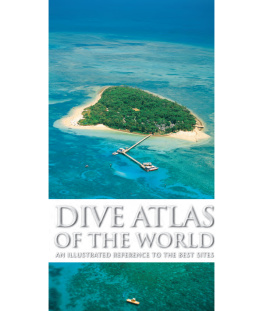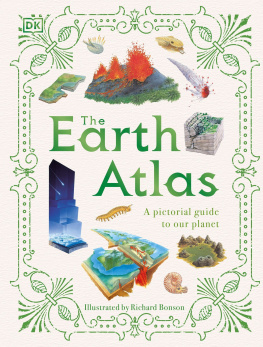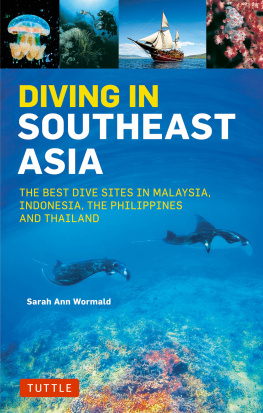Contents
Guide

An aerial view of Green Island, Great Barrier Reef.


A pair of Clown Anemonefish (Amphiprion percula) among the tentacles of their host anemone. Sulawesi, Indonesia.

Cleaner shrimp on anemone, Caribbean.
Published 2016IMM Lifestyle Books
www.IMMLifestyleBooks.com
IMM Lifestyle Books are distributed in the
UK by Grantham Book Service, Trent Road,
Grantham, Lincolnshire, NG31 7XQ.
Copyright 2003, 2016 IMM Lifestyle Books
Copyright 2003, 2016 in text:
individual authors
Copyright 2003, 2016 in maps:
IMM Lifestyle Books
Copyright 2003, 2016 in photographs:
individual photographers and/or
their agents as listed on
No part of this publication may be reproduced,
stored in a retrieval system or transmitted,
in any form or by any means, electronic,
mechanical, photocopying, recording or
otherwise, without the prior written permission
of the publishers and copyright holders.
eISBN 978-1-6076-5362-2
Printed in Singapore
10 9 8 7 6
2 4 6 8 10 9 7 5 3 1
GENERAL EDITOR Jack Jackson
PUBLISHING MANAGERS Claudia dos Santos and Simon Pooley
COMMISSIONING EDITOR Simon Pooley
PUBLISHER Marille Renssen
STUDIO MANAGER Richard MacArthur
DESIGNER Geraldine Cupido
EDITOR Anna Tanneberger
ILLUSTRATOR Steven Felmore
CARTOGRAPHER Genen Hart
PICTURE RESEARCHER Karla Kik
PROOFREADER/INDEXER Natie and Kobie Ferreira
PRODUCTION Myrna Collins
MARINE BIOLOGY CONSULTANT Dr Charles Anderson
CONTENTS
DIVE ATLAS OF THE WORLD
DIVING THE WORLDS OCEANS AND SEAS



The Red-tipped Sea Star (Fromia monilis) is one of the commonest species of Fromia in the western Pacific and one of the most striking.
DIVE ATLAS OF THE WORLD
INTRODUCTION
by Jack Jackson
TROPICAL ISLANDS, BEACHES, TURQUOISE SEAS AND COLOURFUL reefs attract non-divers, divers and snorkellers alike, but experienced divers also enjoy deep walls in open sea, interaction with marine animals, the bounty of cold waters and the atmosphere of shipwrecks.
Remaining shallow maximizes divers time in the water, but some divers favour short deep bounces, hoping to encounter sharks. While most divers prefer relaxing dives, some seek heart-thumping, shark feeding-frenzies or the adrenaline rush of high-voltage drift dives. Some divers prefer clear, warm water while others are happy with limited visibility or cold water. Wreck fanatics often ignore everything else. Whatever type of diving is preferred, most training agencies will offer a speciality course on how to enjoy it safely. Remember that deep dives, cold water and strong currents are physically demanding and conditions can change quickly, so always be prepared to abort a dive.
We have chosen popular sites for each region, with a good range of underwater environments and geographical coverage. Our criteria included quality, quantity, beauty and uniqueness of marine life, accessibility and the requirement of only a reasonable degree of physical fitness. The selection offered here celebrates the underwater world while appealing to a broad spectrum of active and armchair divers.
The book is organized according to oceans and regions within those oceans, beginning with the Atlantic and working west to east and north to south. Practical information is given in the directory appendix.
There is considerable diversity among diving destinations. Most temperate and warm water species or seawater and freshwater species do not mix. Where regions become isolated, either permanently or temporarily such as when ice ages lowered sea levels and cut off the Red Sea, Gulf of Aden and the Arabian Gulf from the Indian Ocean, some species evolve in isolation and become endemic to those regions. Coral reefs harbour many colourful species. Nutrient-rich, cold waters offer abundant marine life that is often larger and longer-living than its tropical counterpart. Some regions have large tidal ranges. Under ice, over rock or coral and over deep water visibility can be exceptional, but where there is a large tidal flow, a sandy or muddy bottom or a plankton bloom, visibility can be awful.
Most coral reef life evolved in what is now the region bordered by the Philippines, Malaysia and Papua New Guinea and then spread out to colonize other regions. The Atlantic Ocean formed late in geological time and, early in its development, was cut off from the Pacific by North and South America fusing together. The connecting ridges in the eastern Caribbean also prevent the interchange of deep water from the Atlantic into the Caribbean. Partly as a result of being cut off on west and east, the Caribbean has fewer marine species than the Indo-Pacific.
Many Caribbean countries have sophisticated ambience, extensive facilities, maximum water clarity, habituated animal encounters and often current-free diving, a package that is particularly attractive to divers on vacation. The Indo-Pacific has the greatest species diversity, though the high level of plankton that feeds this profusion of life often degrades visibility. Some Pacific areas have strong currents and one tide each day much stronger than the other.
SHORE DIVING
Entering the water from a beach or jetty is relatively simple, but climbing over slippery rocks in full diving gear can be difficult. When entering from the rocks of a slope or wall, divers will require knowledge of the local tides because low water could result in a large drop into the water and a height too great for divers to be able to exit the water. There may be long swims across fringing reefs and photographers have extra problems with grit. Shore diving is cheaper than day-boat diving, but most of the accessible sites are not as good as those on offshore reefs.
DAY-BOAT DIVING
Day boats leave the shore for near-shore dive sites once or twice a day (few operators offer three per day). Night dives are optional. Frequently, equipment needs to be carried to and from the beach or jetty. As with any form of boat diving someone must be delegated to ensure that everyone who should be on board is on board when it departs and, most importantly, when it leaves the dive site.

























